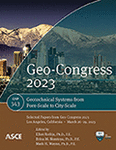Balancing Availability, Quality, Economics, and the Environment When Using Steel Slag within Pavements
Publication: Geo-Congress 2023
ABSTRACT
This paper provides guidance on how to balance matters related to the environmental stewardship, market sources, origin and uses, material properties, performance, and economic impact, of using slag materials in pavements. Literature has numerous references on use of slag materials for specific applications, and this paper aims to make us of those references alongside other data from the authors to describe slag materials in a holistic perspective and provide some suggestions for balancing several factors that affect optimal use of this resource within pavements and geo-infrastructure. Discussion is given to the increased importance of recycling of other materials into the infrastructure and benchmarking those materials against recycling of steel slag. Ensuring adequate performance of pavements while increasing recycled materials usage and maintaining safety is a successful measure relative to green initiatives and only occurs due to careful planning, cooperation, and field validations.
Get full access to this article
View all available purchase options and get full access to this chapter.
REFERENCES
Aiban, S. (2006). “Utilization of Steel Slag Aggregate for Road Bases,” Journal of Testing and Evaluation, 34(1), doi: https://doi.org/10.1520/JTE12683.
ASA [Australasian (iron and steel) Slag Association Inc.]. (2004). Material classification of basic oxygen steel furnace slag - inert. Wollongong: ASA.
Behnood, A., and Ameri, M. (2012). “Experimental Investigation of Stone Matrix Asphalt Mixtures Containing Steel Slag,” Scientia Iranica, 19(5), 1214–1219.
Bennert, T., Haas, E., Tulanowski, D., and Wass, E. (2021). Pavement Support Program Subtask 1.2 Evaluation of Electric Arc Furnace (EAF) Steel Slag in Hot Mix Asphalt. Piscataway: Center for Advanced Infrastructure and Transportation (CAIT).
Chen, W., Wei, J., Xu, X., Zhang, X., Han, W., Yan, X., Hu, G., and Lu, Z. (2021). “Study on the Optimum Steel Slag Content of SMA-13 Asphalt Mixes Based on Road Performance,” Coatings, 11, 1436. https://doi.org/10.3390/coatings11121436.
Cox, B. C., Smith, B. T., Howard, I. L., and James, R. S. (2017). “State of Knowledge for Cantabro Testing of Dense Graded Asphalt,” Journal of Materials in Civil Engineering, 29(10), 04017174.
Crisman, B., Ossich, G., Bevilacqua, P., and Roberti, R. (2019). “Degradation Prediction Model for Friction of Road Pavements with Natural Aggregates and Steel Slags,” Applied Sciences, 10(1), 32; https://doi.org/10.3390/app10010032.
Dahhan, A. (2017). Stone Matrix Asphalt (SMA) Case Study, Thornton, Illinois: Analysis of 20-Year-Old SMA Binder and Surface Course on Williams at Margaret Street. Chicago Testing Laboratory Inc.
Diaz-Piloneta, M., Terrados-Cristos, M., Alvarez-Cabal, J., and Vergara-Gonzalez, E. (2021). “Comprehensive Analysis of Steel Slag as Aggregate for Road Construction: Experimental Testing and Environmental Impact Assessment,” Materials, 14(13), 3587. https://doi.org/10.3390/ma14133587.
Eldin, N. N. (2002). “Road Construction: Materials and Methods,” Journal of Environmental Engineering, 128(5), 423–430.
Emery, J. J. (1982). “Slag Utilization in Pavement Construction, Extending Aggregate Resources,” ASTM Special Technical Publication 774, 95–118, doi: https://doi.org/10.1520/STP32459S.
FHWA (Federal Highway Administration). (1997). User Guidelines for Waste and Byproduct Materials in Pavement Construction., Federal Highway Administration, Washington DC.
GSA (General Services Administration). (2022). Environmentally Preferable Asphalt Standards for all GSA Projects. General Services Administration, Accessed March 29, 2022. https://www.gsa.gov/cdnstatic/Environmentally%20preferable%20asphalt%20SOW%20language%203-29-2022_0.pdf.
Holtz, K., and Eighmy, T. (2000, July). Scanning European Advances in The Use of Recycled Materials in Highway Construction. USDOT - FHWA, Accessed July 2022. https://highways.dot.gov/public-roads/julyaugust-2000/scanning-european-advances-use-recycled-materials-highway-construction.
Howard, I. L., Baumgardner, G. L., Jordan, W. S., Hemsley, J. M., and Hopkins, C. (2021). “Comparing Ground Tire Rubber, Styrene-Butadyene-Styrene, and GTR-SBS Hybrids as Asphalt Binder Modifiers,” Journal of Materials in Civil Engineering, 33(5), 04021091.
Muensch, S. T., Anderson, J. L., Hatfield, J. P., Koester, J. R., and Soderlund, M. (2011). Greenroads Manual v1.5. Seattle, WA: University of Washington.
NAPA (National Asphalt Pavement Association). (2019). Asphalt Pavement Industry Survey on Recycled Materials and Warm-Mix Asphalt Usage. Information Series 138, National Asphalt Pavement Association.
NAPA-1. (2022). Product Category Rules for Asphalt Mixtures (version 2.0 DRAFT). Retrieved from National Asphalt Pavement Association. https://www.asphaltpavement.org/uploads/documents/Programs/Emerald_Eco-Label_EPD_Program/PCR_Public_Comment_Period/NAPA_PCR_Revision_v2_PublicDraft.pdf.
NAPA-2. (2022). Plastics in Asphalt. Retrieved from National Asphalt Pavement Association: https://www.asphaltpavement.org/expertise/engineering/plastics-in-asphalt.
NSA. (2021). Slag Availability. Retrieved from National Slag Association. https://nationalslag.org/slag-availability/.
Nippon Slag Association. (2018). Amounts of Steel Slag Produced and Used in FY 2017. Retrieved from Iron and Steel Slag Statistics. https://www.slg.jp/pdf/Amounts%20of%20steel%20Slag%202017FY.pdf.
Noureldin, A., and McDaniel, R. (1990). “Performance Evaluation of Steel Furnace Slag-Natural Sand Asphalt Surface Mixtures,” Journal of the Association of Asphalt Paving Technologists, 59, 276–303.
PAVExpress. (2022). PAVExpress Website. Retrieved from https://pavexpress.com/.
Pramukh, N., Jayadeva, M., Sona, R., Shashank, S., and Sagar, A. (2018). “Replacement of Coarse Aggregate with Steel Slag in Hot Mix Asphalt,” International Journal of Research in Engineering and Technology, 7(7), 128–131.
Schroeder, R. L. (1994). “The Use of Recycled Materials in Highway Construction,” Public Roads, 57(2), Autumn Edition.
USGS. (2022). National Minerals Information Center. Retrieved from Iron and Steel Statistics and Information: https://www.usgs.gov/centers/national-minerals-information-center/iron-and-steel-statistics-and-information.
Willis, J. R., and Howard, I. L. (2020). “Asphalt Recycling: History of Recycled Materials and Lessons Learned About Recycling Plastic,”, November-December Issue, pp. 21-27.
Wu, S., Xue, Y., Ye, Q., and Chen, Y. (2007). “Utilization of Steel Slag as Aggregates for Stone Mastic Asphalt (SMA) Mixtures,” Building and Environment, 42(7), 2580–2585.
Information & Authors
Information
Published In
History
Published online: Mar 23, 2023
Authors
Metrics & Citations
Metrics
Citations
Download citation
If you have the appropriate software installed, you can download article citation data to the citation manager of your choice. Simply select your manager software from the list below and click Download.
